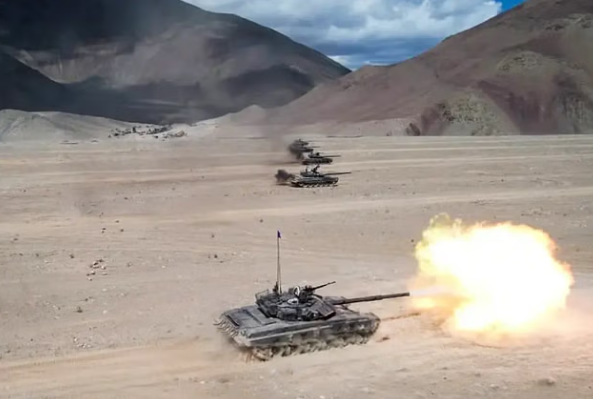Indian Army Conducts ‘Parvat Prahaar’ Military Exercise in Ladakh (GS Paper 3, Defence)

Introduction
- On August 9, 2024, the Indian Army launched a significant military exercise named ‘Parvat Prahaar’ in the rugged and strategically crucial region of Ladakh.
- This exercise is designed to enhance the army’s readiness for high-altitude warfare, reflecting the ongoing security challenges along the India-China border.
Overview of ‘Parvat Prahaar’
- Translation and Purpose: The name ‘Parvat Prahaar’ translates to “Mountain Strike,” indicative of its focus on mountain warfare. The exercise aims to equip soldiers with the skills and tactics needed to operate effectively in high-altitude and challenging terrain typical of Eastern Ladakh.
- Duration: The exercise is conducted over a two-week period, allowing for comprehensive training and simulation of real-world combat scenarios.
- Objectives: Key objectives include improving soldiers' physical and tactical capabilities in mountainous conditions, testing advanced military equipment, and refining operational strategies for potential conflicts.
Participating Forces and Equipment
The exercise involves a wide range of military assets and forces:
Infantry:
- Role: Ground troops trained for combat in difficult terrains.
- Training Focus: Adaptation to high-altitude conditions, endurance, and tactical maneuvers in rugged environments.
Armoured Units:
- Equipment: Tanks and other heavily protected vehicles.
- Role: Provide armored protection and heavy firepower, crucial for engaging in mountainous terrains where mobility and protection are paramount.
Artillery:
- Equipment: Includes advanced artillery systems like the K-9 Vajra, which is known for its mobility and firepower.
- Role: Deliver long-range fire support, essential for striking enemy positions from a distance and supporting infantry operations.
Logistical Support:
- Role: Ensures the supply chain and maintenance of troops, equipment, and ammunition.
- Importance: Vital for sustaining operations in remote and high-altitude areas where supply lines can be challenging to maintain.
Advanced Military Assets:
- Air Defence Systems: To protect against aerial threats and ensure air superiority.
- Unmanned Aerial Vehicles (UAVs): Drones used for surveillance, reconnaissance, and targeted strikes, enhancing operational intelligence and precision.
Background of Tensions
The exercise is conducted against a backdrop of ongoing tensions between India and China, particularly following the Galwan Valley clash in 2020. Key aspects include:
- Historical Tensions: The clash in Galwan Valley, involving violent confrontations between Indian and Chinese troops, heightened border tensions and led to a significant military buildup on both sides.
- Military Deployment: In response, India has strengthened its military posture in Ladakh with:
- 500+ Tanks: Deployed to provide heavy firepower and protection.
- 50,000 Troops: Increased troop presence to secure the border and maintain readiness.
- Infrastructure Development: Investments in roads, logistics bases, and other infrastructure to support military operations in the region.
Mountain Strike Corps:
- Role: A specialized unit within the Indian Army’s Northern Command, tasked with conducting operations along the Line of Actual Control (LAC) with China.
- Responsibilities: Includes rapid deployment, high-altitude combat, and securing strategic positions along the border.
Historical Context of ‘Parvat Prahaar’
- Initiation: Launched in 1987, the operation was originally focused on addressing militancy in the Himalayan regions, specifically in Jammu and Kashmir.
- Focus on High-Altitude Warfare: Emphasized specialized training for soldiers to operate effectively in high-altitude conditions, which include:
- Physical Conditioning: Adaptation to low oxygen levels and harsh weather conditions.
- Tactical Training: Techniques and strategies for combat in mountainous terrain.
Strategic Approach:
- Active Measures: Direct military action against militant groups.
- Passive Measures: Building trust with local communities to discourage recruitment into militant groups.
- Broader Goals: Aimed at countering terrorism and establishing long-term peace and stability in the region.
Significance of the Exercise
The ‘Parvat Prahaar’ exercise is a crucial component of India’s military strategy, serving several purposes:
- Enhanced Readiness: Prepares the Indian Army for potential high-altitude conflicts by simulating real combat conditions.
- Operational Efficiency: Tests and refines tactics, techniques, and equipment to ensure effectiveness in mountainous terrain.
- Strategic Deterrence: Demonstrates India’s preparedness and capability to respond to potential threats along the border, contributing to strategic stability.
By conducting such exercises, the Indian Army aims to maintain operational superiority, ensure the safety and security of the region, and reinforce its strategic posture in the face of ongoing regional challenges.


